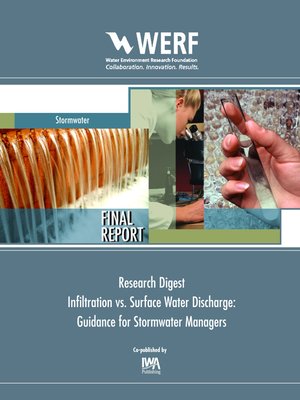Research Digest--Infiltration vs. Surface Water Discharge
ebook ∣ Guidance for Stormwater Managers · WERF Research Report
By Shirley E. Clark

Sign up to save your library
With an OverDrive account, you can save your favorite libraries for at-a-glance information about availability. Find out more about OverDrive accounts.
Find this title in Libby, the library reading app by OverDrive.



Search for a digital library with this title
Title found at these libraries:
| Library Name | Distance |
|---|---|
| Loading... |
Urban stormwater runoff contributes to the degradation of receiving surface waters and groundwater. This degradation is caused both by the increased flows that result from urbanization (i.e., the conversion of land surfaces from being infiltration zones to impervious zones) and by the pollutants (chemical and microbiological) that are carried by runoff.
Stormwater management aims to address these problems. It is a fundamental component of site development for new construction and often is required to the maximum extent practicable for redevelopment of urban/suburban lands to minimize/remediate the impacts of urbanization. To assist practitioners of stormwater management (engineers, regulators, plan reviewers, etc.), many regulatory agencies have developed guidance documents to assist in the design of stormwater treatment devices. These manuals typically provide information on approved practices, and many provide information regarding the anticipated performance of these devices to abate flow, targeted pollutants, or both.
This Research Digest and the Final Report for project 04SW3 (referred to herein as the "full document") are not intended to supplant agencies' guidance documents. Instead, they are designed to supplement their content. They also should aid in focusing stormwater management planning, design, and implementation more toward the intended purpose of protecting the receiving water, whether it is ground- or surface water, rather than toward solely fulfilling a regulatory requirement. The documents provide the user with tools to evaluate whether the planned management strategies will meet the regulatory requirement, as well as potentially improving the receiving water quality, or at least preventing degradation.
This is a companion piece to the full WERF report 04-SW-3 Infiltration vs. Surface Water Discharge: Guidance for Stormwater Managers.
Stormwater management aims to address these problems. It is a fundamental component of site development for new construction and often is required to the maximum extent practicable for redevelopment of urban/suburban lands to minimize/remediate the impacts of urbanization. To assist practitioners of stormwater management (engineers, regulators, plan reviewers, etc.), many regulatory agencies have developed guidance documents to assist in the design of stormwater treatment devices. These manuals typically provide information on approved practices, and many provide information regarding the anticipated performance of these devices to abate flow, targeted pollutants, or both.
This Research Digest and the Final Report for project 04SW3 (referred to herein as the "full document") are not intended to supplant agencies' guidance documents. Instead, they are designed to supplement their content. They also should aid in focusing stormwater management planning, design, and implementation more toward the intended purpose of protecting the receiving water, whether it is ground- or surface water, rather than toward solely fulfilling a regulatory requirement. The documents provide the user with tools to evaluate whether the planned management strategies will meet the regulatory requirement, as well as potentially improving the receiving water quality, or at least preventing degradation.
This is a companion piece to the full WERF report 04-SW-3 Infiltration vs. Surface Water Discharge: Guidance for Stormwater Managers.







